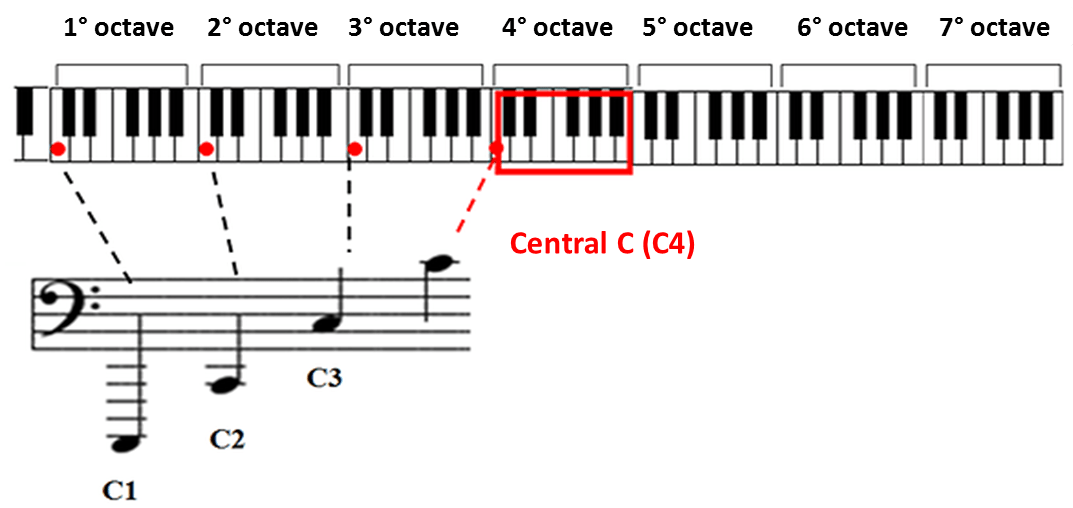
Recording notes of different octaves in the bass clef
Contents
The bass clef is used to record medium and low notes. Notes of small and large octaves, as well as counteroctaves and subcontroctaves, are recorded in this key. In addition, sometimes the bass clef is used for several notes from the first octave.
If the names of octaves are currently unfamiliar to you, then we recommend that you study the article Location of Notes on the Piano. Briefly explain, in the musical scale constantly, but each time at different heights, the same seven main notes are repeated – DO RE MI FA SOL LA SI. And each such repetition of this “set” of sounds is called an OCTAVE. Octaves are named depending on the height of the location in the overall musical scale.
The essence of the bass clef
The second name of the bass clef is the FA clef. So he was nicknamed because by his position on the musical staff (and he is tied to the fourth line) he points to the note FA of a small octave. The note FA of a small octave is a kind of reference point in the bass clef system, and the location of all other notes can be calculated if you remember where this very FA is written.
So, the next steps that surround FA are MI (bottom) and SALT (top). Accordingly, on the stave, these notes will be located around the FA. If it is known that FA occupies, like a bead on a string, sits on the fourth line, then it is easy to guess that the address of the note MI is under the fourth line (more precisely, between the third and fourth), and the permanent place of residence of the SOL is above the fourth line (it is placed between the fourth and fifth lines). In the same way, you can figure out where to write all the other notes. For example, the notes RE and LA will occupy, respectively, the third and fifth line of the stave.
Look at the picture and remember the main thing!

Notes of a small octave in the bass clef
Notes of a small octave, when written in the bass clef, occupy the main space of the stave (the top three lines). This indicates that these notes can be classified as the most frequently used in music, which means that they need to be known best.
In the figure, all the notes of a small octave are written out. Look carefully:

- The note DO of the small octave is located between the second and third lines of the stave.
- Note PE of a small octave, its address on the stave is the third line.
- Note MI of a small octave is written between the third and fourth lines.
- Note FA of a small octave takes its crown place – the fourth line.
- Note SOL small octave should be sought between the fourth and fifth rulers.
- The note LA of the small octave shines on us from the fifth line.
- The SI note of a small octave is located above the fifth line, above it.
Now look at the picture again. Here, the notes of the small octave are not given in a row, but are mixed, try to remember them by name and name each of them without errors.

Large octave notes in the bass clef
Large octave notes are almost as common in music as small octave notes. To record the notes of this range, the two lower rulers of the stave are used, as well as two additional rulers from the bottom. Let’s look at the picture:

- The note DO of a large octave is written on the second additional line from the bottom.
- The PE note of the large octave occupies a position under the first additional ruler.
- The note MI of the big octave is “strung” on the first additional line of the staff.
- The note FA of a large octave is located under the first main line of the stave.
- The note G of a large octave “sits” on the first line of the staff.
- The note LA of a large octave hid between the first and second rulers.
- The SI note of the large octave should be looked for on the second line of the staff.
Notes of the contra-octave in the bass clef
The sounds of the counteroctave are very low, usually they are rare. But still, those who play the organ, piano, or low tessitura instruments (tuba, double bass) sometimes come across them in notes. These notes can be written in two ways: either entirely on additional rulers, or using the OCTAVE DOTS.
What is an octave dotted line? This is a simple dotted line with the number eight at the beginning, and all the notes that this line hugs from the bottom must be played an octave lower. The octave dotted line is a very convenient way to avoid a large number of additional rulers, which, on the one hand, slow down the process of recognizing notes, and on the other hand, make recording more cumbersome.
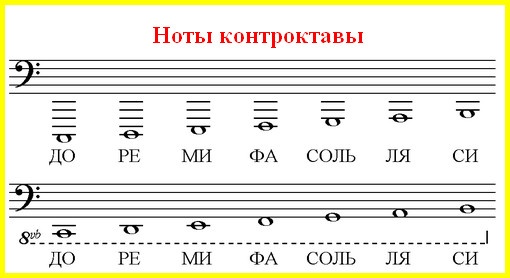
By the way, octave dotted lines can also have the opposite effect, when everything that is under the dotted line should be played an octave higher. These are dotted lines for high notes, you can read about them in the article Treble Clef Notes.
If, nevertheless, the notes of the counteroctave are written without the use of an octave dotted line, then in this case their location on the stave will be as follows.
- The note DO of the counteroctave is written under the fifth line from the bottom.
- The PE note of the contra-octave occupies the fifth auxiliary line added at the bottom of the stave.
- The MI note of the counteroctave is located under the fourth additional line.
- Note FA of the contra-octave is “fitted” on the fourth additional line itself.
- The note SO of the counteroctave “hangs” under the third additional line from the bottom.
- Note LA of the counteroctave is written on the third additional line.
- The SI note of the counteroctave occupies a position under the second additional line of the stave.
Subcontroctave notes in the bass clef
The subcontroctave is the “habitat” of the lowest notes, which are very rare. The subcontroctave, moreover, is also an incomplete octave, it has only two main steps – LA and SI. If these notes are recorded on additional rulers, then there will be a huge number of these rulers. Therefore, subcontroctave notes are always written under octave dotted lines: as counteroctave notes under an ordinary octave dotted line, or as notes of a large octave under a special double octave dotted line.
What is a double octave dotted line – this is exactly the same dotted line, but with the number 15, which indicates that the notes must be played two whole octaves lower.
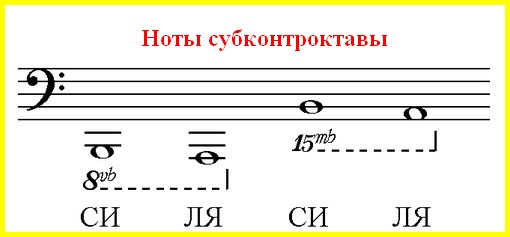
Notes of the first octave in the bass clef
In general, most often the notes of the first octave are written in the treble clef, but for low instruments or for male voices, often the notes of the first octave (not all, but only some of them) are written in the bass clef, on the additional lines from above (above the fifth main note line). camp). Such a recording is typical mainly for the five notes of the first octave – DO, RE, MI, FA and SOL.
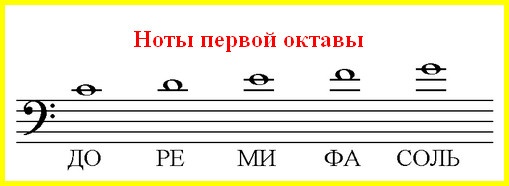
- The note BEFORE the first octave in the bass clef is written on the first additional line from above.
- The note PE of the first octave in the bass key is located above the first additional, that is, above it.
- The note MI of the first octave in the bass clef occupies the second upper additional line.
- The note FA of the first octave in the bass clef “lies” above the second additional one, above it.
- The note SOL of the first octave in the bass clef is quite rare, its address is the third upper additional line of the stave.
The bass clef in music, along with the treble clef, is the most common, so every self-respecting musician needs to know its notes for a solid five. To better memorize the notes of the bass clef, you need to practice more in reading and rewriting the notes of this key. Here, for example, you have a melody, read all its notes in a row:
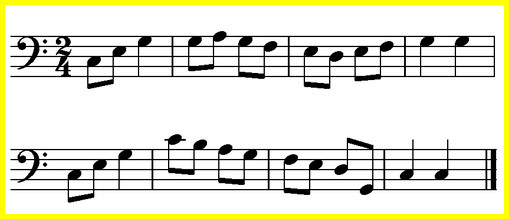
Happened? Now transcribe this melody an octave higher and then an octave lower. You can find more melodies for exercises in the bass clef in any collection for singing in solfeggio.
Another good option for working out the bass clef for better assimilation is to complete written and creative tasks, solve rebuses, musical riddles. A number of fascinating and simple, but at the same time very effective exercises of this kind are collected in the solfeggio workbook for grade 1 by G. Kalinina. We strongly advise you to purchase such a workbook and work through all its tasks, you will immediately feel more confident and savvy as a musician. And now we invite you to get acquainted with a selection of exercises in the bass clef closer – DOWNLOAD EXERCISES.
This concludes our today’s lesson. Dear friends, we will be very happy if the material presented will help you to advance at least a little in your musical studies. But if you still have unresolved questions or have suggestions for improving this lesson, you can write to us about it in the comments. None of your messages will go unnoticed.
And finally… Some good music. Today it will be the most beautiful and simply magical music by C. Saint-Saens, “Aquarium” from the suite “Carnival of the Animals”





